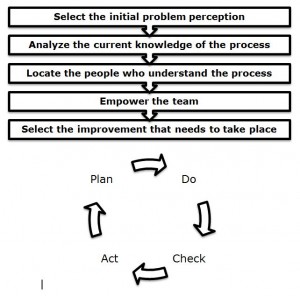SALES PDCA is the framework I use for the process that takes place in the customer groups. It is nothing more than a standard PDCA cycle except the SALES part of the framework is where the sales team gets its directions and coaching from the team coordinator and value stream manager. Within the actual PDCA stage the sales team is empowered to make their own choices and determine their own direction to accomplish the goals of that cycle. This framework is introduced in the Marketing with PDCA book.
The individual stages of the SALES – PDCA framework are as follows:
Select the initial problem perception
Analyze the current knowledge of the process
Locate the people who understand the process
Empower the team
Select the improvement that needs to take place
Plan the improvement that needs to take place and plan the change
Do it the new way, execute the plan.
Check the results of the plan to determine whether the plan worked.
Act on the results. If the plan worked, standardize the change. If it didn’t work, readjust and go through the cycle again.
Select the initial problem perception: There are two ways to initiate the SALES PDCA. One is that the interest of the customer is initiated from a handoff from another team. Except for the initial stage (which is the awareness or involvement stage in many funnels), this is a handoff that is being passed from one cycle to the next or to another team. For example, the collaboration sales group may turn over a lead to the sale/buying team when they need more technical knowledge or have sent a signal that they are ready for a higher degree of interaction. The customers or the prospects perception should also be stated and can be as simple as, what is the problem to be solved and will this deliver value to the customer?
Analyze the current knowledge of the process: The analyze phase is a quick review of the critical-to-quality (CTQ) issues facing this value stream and how they may apply to this cycle. What should be involved in this step? Have customers’ expectations and specifications been examined and documented? What are the points of concern? It is critical to have a clear understanding of the perspective of the customer or prospect.
Locate the people who understand the process: One of the key considerations in developing a team is to determine the objective of the cycle. Is it primarily problem-resolution, creativity, or tactical execution? Team structure needs to be considered as well as the participants. You will find a variety of structures will work for you but the typical model in sales and marketing is one of a business team that has a team leader and all others are on equal footing. Many times the team leader is really just a participant but has the administrative work as an added responsibility.
Empower the team: One of the major changes that a Lean process takes over a traditional sales engagement is the role of understanding how value is created. We need a certain degree of expertise to satisfy a customer’s need but the engagement is as important as the expertise. Talking to your customer is an important part of the process and many new teams are unfamiliar with this role. The salesperson is an integral part of the process to bridge that understanding initially. These experiences or touch points with customers are what solidifies the relationship between customer and vendor. Your team needs to have autonomy in these exchanges or the network will bog down and become unproductive.
Select the improvement that needs to take place: Define the gap of the cycle. It is important that some data exist to support the customer need. It may even be necessary to develop some mechanism for specifically learning the extent of the problem. If this is not done, it may become difficult to show what improvement occurred.
Plan: The Plan stage should take up 50% of your efforts and it is where you define the customer objectives or the problem statement and determine the conditions and methods required to achieve the objectives. It is imperative that you clearly describe the customer need you must fulfill and the goals and policies required to achieve the objectives at this stage. A specific target should be documented numerically, if possible, and the procedures and conditions for the means and methods to achieve the target must be described.
Do: In the Do stage, conditions are created and the necessary training or additional support to execute the plan is implemented. It is important that the sales/marketing teams completely understand the objectives and the plan and are in agreement with the procedures needed to fulfill the plan. The work is then performed according to these procedures.
Check: In the Check stage, one must check to determine whether work is progressing according to the plan and whether the expected results are obtained. The performance of the set procedures must be checked against changes in conditions, or deviations may appear. As often as possible, the results of the work should be compared with the objectives. If a check detects a deviation (actual value differs from the target value) then a search for the cause of the deviation must be initiated to prevent its recurrence.
Act: If the Action stage determines that the work is not being performed according to plan or those results are not what were anticipated, measures must be devised for appropriate action and you go back thru the next project.
Related Information:
The Little PDCA Sales Loop
Power of Check = The Pivot in PDCA
The Role of PDCA in a Lean Sales and Marketing Cycle
Dr. Jeff Liker on PDCA and Lean Culture


Comments are closed.